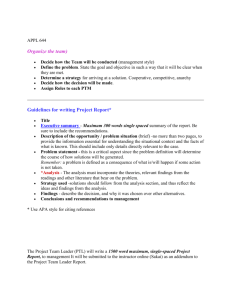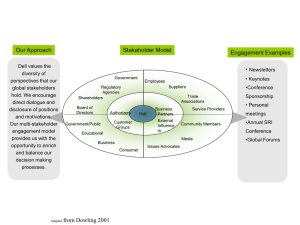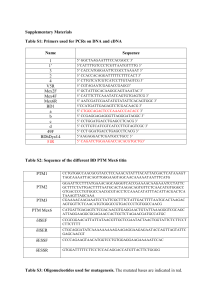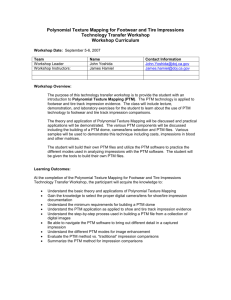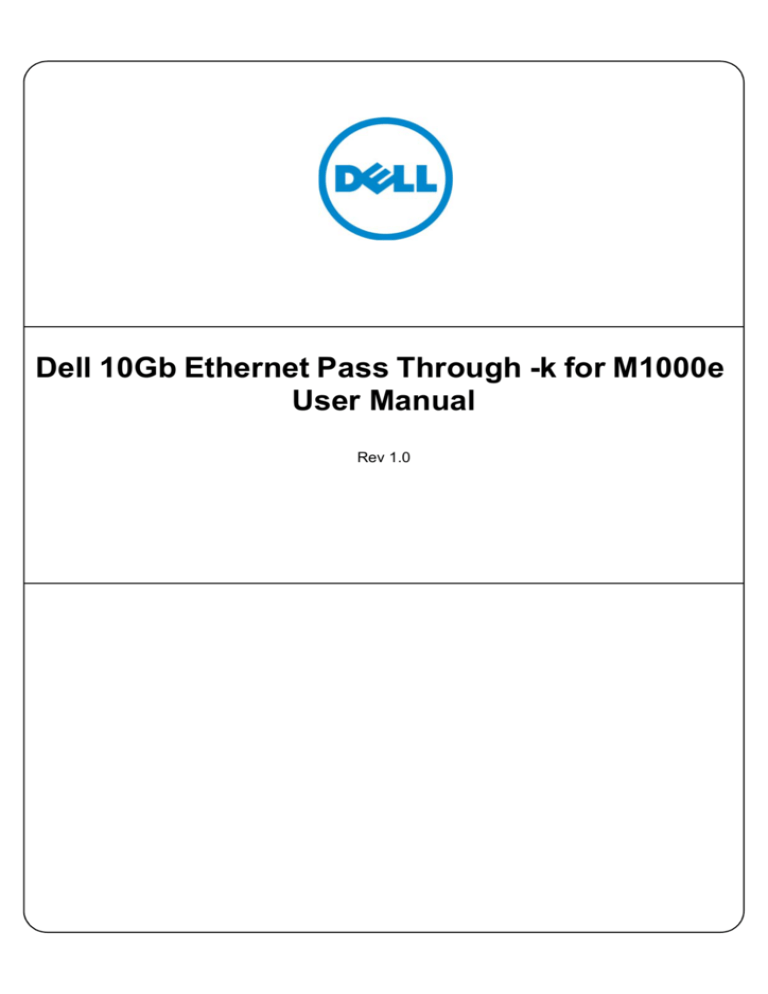
Dell 10Gb Ethernet Pass Through -k for M1000e
User Manual
Rev 1.0
Rev 1.0
____________________
Information in this SXEOLFDWLRQ is subject to change without notice.
© 2010 Dell Inc. All rights reserved.
Reproduction of these materials in any manner whatsoever without the written permission of Dell Inc. is strictly forbidden.
Trademarks used in this text: Dell™, the DELL logo, and PowerEdge™ are trademarks of Dell Inc.
Other trademarks and trade names may be used in this SXEOLFDWLRQ to refer to either the entities claiming the mark and names or their
products. Dell Inc. disclaims any proprietary interest in trademarks and trade names other than its own.
Dec. 2010
Rev: A00
16 Port Pass Through Module
2
Document Number: 3303
Dell -10GbE PTM
Rev 1.0
Table of Contents
Chapter 1
Chapter 2
5
Conventions
5
Overview
6
1.1
Features
6
1.2
Serial Number and Product Version Information
7
Installation and Basic Operation
8
2.1
Unpacking the Pass Through Module
8
2.2
Insertion and Removal of the PTM
8
2.2.1
PTM Insertion
8
2.2.2
PTM Removal
9
Connecting the External Ports
9
2.3.1
10 Gigabit Ethernet SFP+ Modules
9
2.3.2
Installation and Removal of Optical Transceiver Modules
9
2.3
2.4
Chapter 3
Intended Audience
LED Indicators
10
2.4.1
System LEDs
10
2.4.2
Port LEDs
10
2.4.3
Installation Safety Warnings
12
2.4.4
Mechanical Installation
13
2.4.5
Cable Installation
13
Troubleshooting
14
Appendix A Specifications
15
A.1
Mechanical Drawing with Dimensions
17
Appendix B Supported Cables and Media Types
18
Appendix C EMC Certification Statements
19
C.1
FCC Statements (USA)
19
C.2
EN Statements (Europe)
19
C.3
ICES Statements (Canada)
20
C.4
VCCI Statements (Japan)
20
C.5
KCC Certification (Korea)
20
Appendix D Interface Connector Pinouts
D.1
SFP+ Interface
22
22
3
Rev 1.0
Related Documentation
The documentation set accompanying the DEll Pass Through Module includes the following:
Table 1 - Reference Documents and Web Sites
Firmware and Firmware Update Tools
support.dell.com
Dell Pass Through Module Software User Manual support.dell.com
Latest Supported Cables and Optical Modules
Revision History
Table 2 - Revision History
4
Revision
Date
Description
1.0
April 01st, Initial Release
2011
See Supported Cables and Media Types on page 18
in this document
Dell -10GbE PTM
Rev 1.0
About this Manual
This manual describes the installation and basic use of the Dell 10Gb Ethernet Pass Through -k 16
port module for blade servers.
Intended Audience
This manual is intended for users and system administrators responsible for installing and setting
up the Dell 10Gb Ethernet Pass Through -k module for blade servers.
Conventions
The terms downlink (internal–from servers) and uplink (external–out to the world) are used
throughout the document.
Caution: This symbol indicates the possibility of physical injury to the user or
installer.
The term PTM is used to indicate the Dell 10Gb Ethernet Pass Through -k module.
5
Rev 1.0
1
Overview
Overview
The PTM is an I/O module designed for the PowerEdge M1000e Dell Chassis. The product provides 10Gigabit connectivity for blade servers to Ethernet LANs. The product supports the following Ethernet protocols.
Table 3 - Protocols
Physical Connections
Pass Through -k Protocol
Blade Servers to PTM (Internal Links)
KR
Front Panel Ports (External Links)
10G XFI
Each front panel port provides connectivity to the blade with the corresponding number in the
chassis.
Figure 1: Dell 10Gb Ethernet Pass Through -k module Front Panel
1.1
Features
The PTM feature set includes:
Internal Links
• 16 ports of 10Gb Ethernet 10GBASE-KR through the backplane
External links
• 16 SFP+ front panel ports of 10Gb Ethernet
IEEE and Other Ethernet Standards Compliance
• IEEE 802.3ae 10Gigabit Ethernet support
• IEEE 802.3ap Ethernet Operation over Electrical Backplanes
• Including KR startup protocol and Forward Error Correction (FEC) support
• Supports KR auto-negotiation
• Jumbo Frames up to 9K support
Connectors and Cabling
• Twin Axial Pair connector
• Optical modules for SR and LR
• All ports support active cables
6
16
15
14
13
12
11
10
9
8
7
6
5
4
3
10 Gb Ethernet Pass Through -k
2
1
D
D
Dell -10GbE PTM
Rev 1.0
Front Panel Indicators
• Per port status LEDs: Link Up, Link Activity
• System status LEDs: Power Supply, Status
1.2
Serial Number and Product Version Information
The serial number and product version information are found on the label seen in the figure below.
Figure 2: Generic Product label
7
Rev 1.0
Installation and Basic Operation
2
Installation and Basic Operation
2.1
Unpacking the Pass Through Module
Before you install your new PTM, unpack it and make sure that there is no visible damage that
may have occurred during shipping. Your package should contain the following items:
• Dell 10Gb Ethernet Pass Through -k module for Blade Servers
• This Users Manual
The PTM is shipped without optical modules.
If anything in the package is damaged or missing, please contact your customer representative
immediately.
2.2
Insertion and Removal of the PTM
The Dell 10Gb Ethernet Pass Through -k module may be plugged into fabric slots A1, A2, B1, B2,
C1, and C2.
Determine which slot to use, based on desired system configuration.
2.2.1 PTM Insertion
Insert the PTM into the chassis as shown in the following diagram:
Figure 3: Dell Chassis Slots for the PTM
Slot A1
8
Slot B1
Slot C1
Slot C2
Slot B2
Slot A2
Dell -10GbE PTM
Rev 1.0
The PTM supports hot-insertion into the chassis. If the PTM is inserted to a powered chassis, the
power LED (green) should turn on immediately.
2.2.2 PTM Removal
The PTM supports hot-removal. It may be removed when the chassis is powered on or off.
The PTM must not be removed during a firmware update process.
Note: Firmware update is in progress when the Yellow LED is blinking.
2.3
Connecting the External Ports
The PTM front panel presents 16 SFP+ ports. Each port provides connectivity to a server with the
respective number. Figure 4 shows the front panel view of the PTM.
Figure 4: Dell 10Gb Ethernet Pass Through -k module Front Panel
16
15
14
13
12
11
10
9
8
7
6
5
4
3
10 Gb Ethernet Pass Through -k
2
1
D
D
2.3.1 10 Gigabit Ethernet SFP+ Modules
The PTM supports SFP+ modules for 10 Gigabit Ethernet, with 10GBASE-SR and 10GBASE-LR
PHYs. SFP+ modules must be approved for use with this PTM. Modules not approved may not
work. See Supported Cables and Media Types on page 19 for lists of approved Direct Attached
Copper cables (DACs) and optical modules.
2.3.2 Installation and Removal of Optical Transceiver Modules
Optical transceiver modules have a locking mechanism which can be opened or closed.
To insert the module into the cage:
1. Open the module’s locking mechanism.
2. Make sure that the male connectors on the module aligns with the female connector inside of
the cage. Also check that there is no dirt or foreign matter in the module or in the cage.
3. Insert the module into the adapter card module cage.
4. Close the locking Mechanism.
To remove the module from the cage:
1. Unlock the locking mechanism by opening the handle.
2. Pull the module out of the cage.
9
Rev 1.0
2.4
Installation and Basic Operation
LED Indicators
2.4.1 System LEDs
The system status LEDs indicate whether the PTM is receiving power from the chassis, and the
state of the PTM.
There are two system LEDs on the end of the module. The LED indications and meanings are
explained in the figure and table below.
Figure 5: Indicator LEDs
The IO Module is on and
ready when this LED is
green.
This LED can be blue or Yellow. A fault is indicated when
the Yellow LED is blinking.
See Table 4.
Table 4 - PTM states and LED configurations:
LED
Module Status
Indication
Status
Power
OFF
OFF
OFF
OFF
ON
Boot in Progress
PTM not ready
BLINKING BLUE
ON
The CMC is identifying
the newly installed PTM
ON BLUE
ON
PTM is on and operating Normally
ON or BLINKING
Yellow
ON
FW update is in progress or
Fault in System
Self-diagnosed
ON or BLINKING
Yellow
OFF
Fault in System
CMC-detected
Blinking Blue
2.4.2 Port LEDs
The PTM has two I/O LEDs per port. The I/O LEDs are located on the I/O panel. The green LED,
when lit, indicates that the driver is running and a valid physical connection between nodes exists.
If the green LED is blinking, it indicates a problem with the physical link. The yellow LED when
lit, indicates a valid data activity link, this is the logical link. The yellow LED illuminates when the
10
Dell -10GbE PTM
Rev 1.0
network is discovered over the physical link. A valid data activity link without data transfer is designated by a constant yellow LED indication. A valid data activity link with data transfer is designated by a blinking yellow LED indication. If the LEDs are not active, either the physical link or
the logical link (or both) connections have not been established.
Figure 6: Physical and Logical Link Indications
LED
Port Status
Indication
Green
Yellow
OFF
OFF
OFF
ON
OFF
Physical link up
No logical link
BLINKING
OFF
Problem with the physical link
No logical link
ON
ON
Physical link up
Logical link up, no data transfer
ON
BLINKING
Physical link up
Logical link up, with data transfer
11
Rev 1.0
Installation and Basic Operation
2.4.3 Installation Safety Warnings
1. Installation Instructions
Read all installation instructions before connecting the equipment to the power source.
2. Over-temperature
This equipment should not be operated in an area with an ambient temperature exceeding the maximum recommended: 40°C
(104°F). An air flow of 9CFM at this maximum ambient temperature is required.
3. During Lightning - Electrical Hazard
During periods of lightning activity, do not work on the equipment or connect or disconnect cables.
4. Copper Direct Attached SFP+ Cable Connecting/Disconnecting
Copper Direct Attached SFP+ cables are heavy and not flexible,
as such they should be carefully attached to or detached from the
connectors. Refer to the cable manufacturer for special warnings
and instructions.
5.
Equipment Installation
This equipment should be installed, replaced, or serviced only
by trained and qualified personnel.
6. Equipment Disposal
Disposal of this equipment should be in accordance to all
national laws and regulations.
7. Local and National Electrical Codes
This equipment should be installed in compliance with local and
national electrical codes.
8. Hazardous Radiation Exposure
Caution – Use of controls or adjustment or performance of procedures
other than those specified herein may result in hazardous radiation
exposure.
12
Dell -10GbE PTM
Rev 1.0
CLASS 1 LASER PRODUCT and reference to the most recent laser
standards:
IEC 60825-1:2007/03 y EN 60825-1:2007
2.4.4 Mechanical Installation
2.4.4.1 To install the PTM
1. Make sure that there is no foreign matter or dirt in the back plane connector or in the chassis slot.
2. Push the PTM into the chassis. Make sure that the ears on the latch hook onto the latching bar.
3. Push the latch handle towards the orange latch release until it locks.
2.4.4.2 To remove the PTM
1. Push the orange latch release and the latch handle will pop out
2. Pull the handle out until it is 90 degrees from the front of the PTM.
3. Pull the PTM out of the chassis.
2.4.5 Cable Installation
All cables can be inserted or removed with the unit powered on. To insert a cable, press the connector into the port receptacle until the connector is firmly seated. The GREEN LED indicator,
above each SFP+ port, will light when the physical connection is established (that is, when the unit
is powered on and a cable is plugged into the port with the other end of the connector plugged into
a functioning port). After plugging in a cable, lock the connector using the latching mechanism
particular to the cable vendor. When a logical connection is made the yellow light will come on.
When data is being transferred the yellow light will blink.
Always install and remove cables by pushing or pulling the cable and
connector in a straight line with the pass through module.
To remove, disengage the locks and slowly pull the connector away from the port receptacle. Both
LED indicators will turn off when the cable is unseated.
Cable lengths should be used which allow for routing horizontally around to the side of the chassis
before bending upward or downward in the rack.
Cables, especially long copper cables, can weigh a substantial amount.
Make sure that the weight of the cable is supported on its own and not
hanging from the pass through module.
13
Rev 1.0
3
Troubleshooting
Troubleshooting
As soon as a pass through module is plugged in make sure that the status LED shows green.
The power LED for the pass through module shuts off:
1. Check that the there is adequate ventilation.
2. Make sure that there is nothing blocking the front or rear of the chassis and that the fan modules and ventilation holes are not blocked (especially dust over the holes).
3. If you find dust blocking the holes it is recommended to clean the fan unit and remove the dust
from the front and rear panels of the pass through module using a vacuum cleaner.
4. Remove and Reinstall the PTM.
14
Rev 1.0
Appendix A: Specifications
Table 5 - Dell 10Gb Ethernet Pass Through Module Specification Data
Physical
Power and Environmental
Size:
W X D X H 24.7 cm X 28.5 cm X 2.9 cm
Weight: 1.978kg
SerDes Speeds: 10 Gb/s per port
Connectors and
Cabling: SFP+
Optical Cable: Direct attached copper cables supported
Optical cables supported
External Port Types: DAC (SFP+)
Internal Port Types: KR
Air Flow: 3CFM @ 30oC ambient temperature
9CFM @ 40oC ambient temperature
16
Maximum
Power: 40.55W passive cables
56.73W active cables
Typ Power: 34.41W passive cables
50.59W active cables
Temperature: 0° to 40° Celsius
Humidity: 10% - 90% non-condensing
Altitude:
Shock:
Vibration:
Power through
SFP+: max 1W per port
Latency:
Latency (without FEC) 90ns
Latency (with
FEC) 290ns
(FEC is an optional requirement in IEEE802.3ap).
Dell -10GbE PTM
Rev 1.0
Table 5 - Dell 10Gb Ethernet Pass Through Module Specification Data
Physical
Power and Environmental
Protocol Support
Regulatory Compliance
Ethernet: IEEE 802.3ae 10Gigabit Ethernet
support
Blade Servers to
PTM (Internal
Links): IEEE 802.3ap Ethernet Operation
over Electrical Backplanes
QoS: 8 Priority Queues for Ethernet
Safety: UL60950
C-UL to CAN/CSA 22 2
No.60950-1
TUV/GS to EN 60950-1,
Amendment A1-A4, A11
CB-IEC60950-1, all country deviations
EMC CC 47CFR Part 15 Class A
(Emissions): EN 55022 Class A
ICES-003 Class A
VCCI Class A
AS/NZS CISPR 22 Class A
CISPR 22 Class A
EN 55024
EN 300386
CE
Environmental: EU: IEC 60068-2-64: Random Vibration
EU: IEC 60068-2-29:
Shocks, Type I / II
EU: IEC 60068-2-32: Fall
Test
17
Rev 1.0
A.1:
Mechanical Drawing with Dimensions
All dimensions are in centimeters.
Figure 7: Mechanical Drawing
24.7
23.0
5.5
2.9
18
Dell -10GbE PTM
Rev 1.0
Appendix B: Supported Cables and Media Types
The following cables and optical modules are approved for the Dell PTM.
Table 6 - Direct Attached Cables (DAC)
DPN
Reference
Length (m)
Speed
Molex Custom PN
K585N
SFP-H10GB-CU1M
1
10.3125Gbps
74752-9093
J564N
SFP-H10GB-CU3M
3
10.3125Gbps
74752-9094
H603N
SFP-H10GB-CU5M
5
10.3125Gbps
74752-9096
G840N
SFP-H10GB-CU7M
7
10.3125Gbps
74752-9098
R620M
30 AWG
0.5
10.3125Gbps
74752-1051
G692K
30 AWG
1
10.3125Gbps
74752-1101
P540M
30 AWG
2
10.3125Gbps
74752-1201
Y984J
28 AWG
3
10.3125Gbps
74752-2301
N651M
28 AWG
4
10.3125Gbps
74752-2401
C855K
28 AWG
5
10.3125Gbps
74752-3501
Table 7 - Optical Modules
DPN
Reference
Speed
Manufacturer
N743D
ASSY,XCVR,SFP+,LC-LC,SFP+SR
10.3125Gbps
Finisar
T307D
ASSY,XCVR,SFP+,LC-LC,SFP+LR
10.3125Gbps
Finisar
W365M
ASSY,XCVR,SFP+,LC-LC,SFP+SR,AV
10.3125Gbps
Avago
W373M
ASSY,XCVR,SFP+,LC-LC,SFP+LR,AV
10.3125Gbps
Avago
19
Rev 1.0
Appendix C: EMC Certification Statements
Table 8 lists the approved certification status per bridge in different regions of the world.
Table 8 - Bridge Certification Status
Pass through Module P/N
FCC
Class
(USA)
Dell 10GbE Pass Through -k
A
C.1:
EN
ICES
Class
Class
(Europe) (Canada)
A
A
VCCI
(Japan)
cTUVus
KCC
CB
A
FCC Statements (USA)
Class A Statements:
§ 15.21
Statement
Warning! Changes or modifications to this equipment not expressly approved by the party
responsible for compliance could void the user's authority to operate the equipment.
§15.105(a)
Statement
NOTE: This equipment has been tested and found to comply with the limits for a Class A digital
device, pursuant to Part 15 of the FCC Rules. These limits are designed to provide reasonable protection against harmful interference when the equipment is operated in a commercial environment.
This equipment generates, uses, and can radiate radio frequency energy and, if not installed and
used in accordance with the instruction manual, may cause harmful interference to radio communications. Operation of this equipment in a residential area is likely to cause harmful interference
in which case the user will be required to correct the interference at his own expense.
C.2:
EN Statements (Europe)
EN55022 Class A Statement:
Warning: This is a class A product. In a domestic environment this product
may cause radio interference in which case the user may be required to
take adequate measuresmeasures.
20
c-Tick
Dell -10GbE PTM
C.3:
Rev 1.0
ICES Statements (Canada)
Class A Statement:
“This Class A digital apparatus complies with Canadian ICES-003.
Cet appareil numérique de la classe A est conforme à la norme NMB-003 du Canada.”
C.4:
VCCI Statements (Japan)
Class A Statement:
C.4.1:
Translation
"This is a Class A product based on the standard of the Voluntary Control Council for Interference
by Information Technology Equipment (VCCI). If this equipment is used in a domestic environment, radio interference may occur, in which case the user may be required to take corrective
actions."
C.5:
KCC Certification (Korea)
Korea's "Regulation for Certification of Information and Communication Equipment," requires
EMC testing and certification for many electronic products. Korean EMC certifications are issued
by Radio Research Laboratory (RRL), which is organized under the Ministry of Information and
Communications (MIC). EMC testing includes electromagnetic emissions (EMI) and susceptibility (EMS). Certified equipment is labeled with the MIC mark and certification number.
21
Rev 1.0
C.5.1:
Translation:
“Class A Device This device is registered for EMC requirements for industrial use. The seller or
buyer should be aware of this. If this type was sold or purchased by mistake, it should be replaced
with a residential-use type.”
22
Dell -10GbE PTM
Rev 1.0
Appendix D: Interface Connector Pinouts
D.1:
SFP+ Interface
VeeT
2
1
TX_Fault
VeeT
20
TD3
TX_Disable
19
4
SDA
18
TD+
VeeT
5
SCL
17
6
MOD_ABS
16
7
RS0
15
VccT
VccR
VeeR
RX_LOS
8
14
RD+
13
9
RS1
12
10
VeeR
11
RD-
VeeR
Figure 8: SFP+ Connector Pinout - Rear View of Module With Pin Placement
Table 9 - SFP+ Pinout
Pin
Symbol Name
Description
1
VeeT
Transmitter Ground (Common with Receiver Ground) a
2
TX_Fault
Transmitter Fault.b
3
TX_Disable
Transmitter Disable. Laser output disabled on high or open. c
4
SDA
2-wire Serial Interface Data Line d
5
SCL
2-wire Serial Interface Clock Line d
6
MOD_ABS
Module Absent. Grounded within the module d
7
RS0
No connection required
8
RX_LOS
Loss of Signal indication. Logic 0 indicates normal operation. e
9
RS1
No connection required
10
VeeR
Receiver Ground (Common with Transmitter Ground) a
11
VeeR
Receiver Ground (Common with Transmitter Ground)a
12
RD-
Receiver Inverted DATA out. AC Coupled
13
RD+
Receiver Non-inverted DATA out. AC Coupled
14
VeeR
Receiver Ground (Common with Transmitter Ground) a
23
Rev 1.0
Table 9 - SFP+ Pinout
Pin
Symbol Name
Description
15
VccR
Receiver Power Supply
16
VccT
Transmitter Power Supply
17
VeeT
Transmitter Ground (Common with Receiver Ground) a
18
TD+
Transmitter Non-Inverted DATA in. AC Coupled.
19
TD-
Transmitter Inverted DATA in. AC Coupled.
20
VeeT
Transmitter Ground (Common with Receiver Ground)a
a. Circuit ground is internally isolated from chassis ground.
b. TFAULT is an open collector/drain output, which should be pulled up with a 4.7k – 10k
Ohms resistor on the host board if intended for use. Pull up voltage should be between 2.0V
to Vcc + 0.3V. A high output indicates a transmitter fault caused by either the TX bias current or the TX output power exceeding the preset alarm thresholds. A low output indicates
normal operation. In the low state, the output is pulled to <0.8V.
c. Laser output disabled on TDIS >2.0V or open, enabled on TDIS <0.8V
d. Should be pulled up with 4.7kΩ – 10kΩ on host board to a voltage between 2.0V and 3.6V.
MOD_ABS pulls line low to indicate module is plugged in.
e. LOS is open collector output. Should be pulled up with 4.7kΩ – 10kΩ on host board to a
voltage between 2.0V and 3.6V. Logic 0 indicates normal operation; logic 1 indicates loss of
signal.
24

